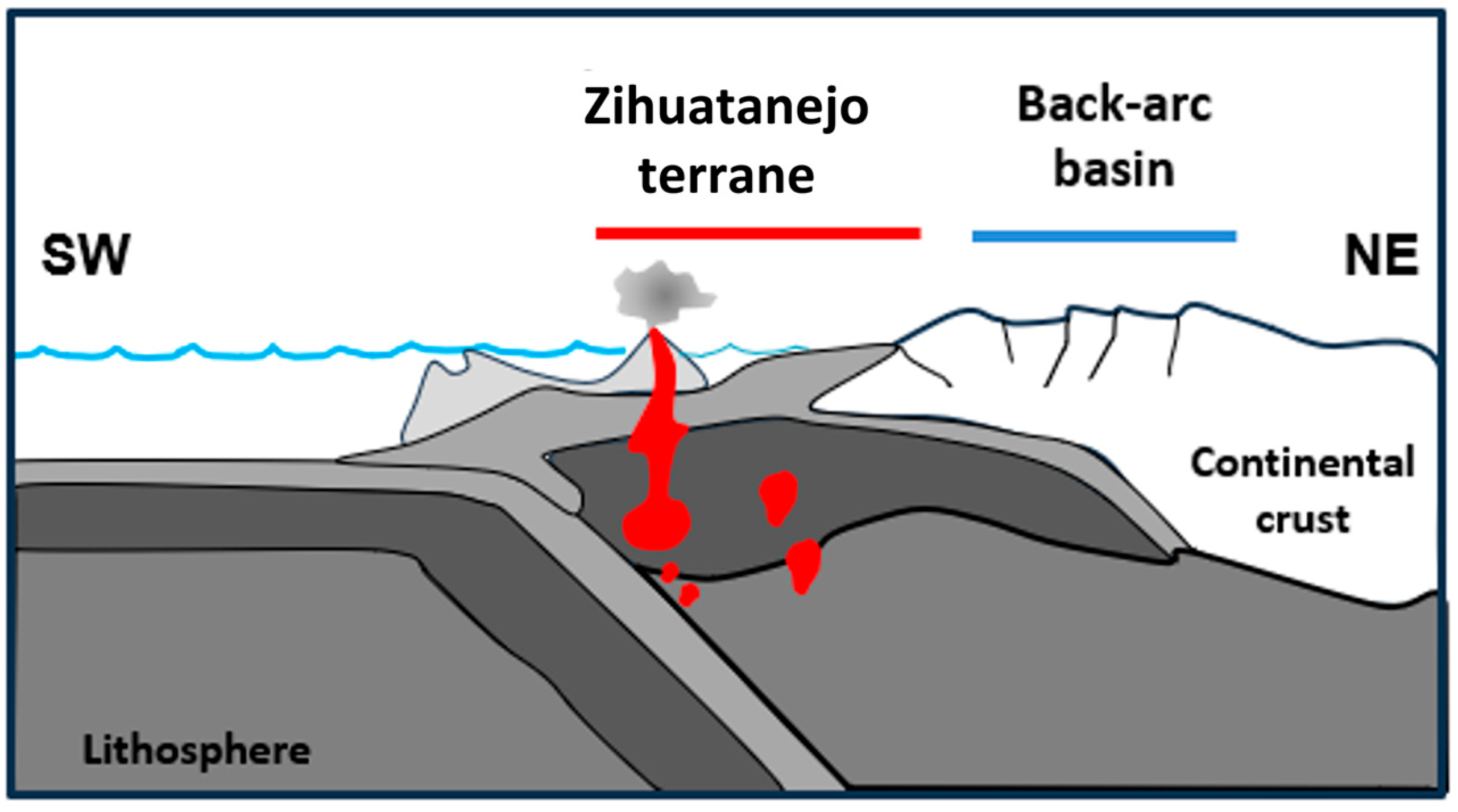The Shallow Structure of the Jalisco Block (Western Trans-Mexican Volcanic Belt) Inferred from Aeromagnetic Data—Implications for Mineral Deposits
Abstract
1. Introduction
2. Geological Background
3. Mineral Resources: Gold and Iron
4. Aeromagnetic Data
Aeromagnetic Interpretation
5. Magnetic Anomaly Modeling
6. Concluding Remarks
- Complex Geodynamic Evolution and Associated Mineralization.The long-term interaction between the North American and Farallon tectonic plates along a subduction zone led to the accretion of tectonostratigraphic terranes and the formation of numerous mineral deposits, particularly in southwestern Mexico (Figure 11). Under these particular geodynamic configurations, the Guerrero Terrane and the Jalisco Block represent key regions for mineral exploration.
- Metallogenic Significance of the Guerrero Terrane.The structural and magmatic evolution of the Guerrero Terrane—including the emplacement of intrusive rocks into carbonate-rich sequences—favored the development of iron- and gold-rich skarn systems, porphyry-type deposits, and epithermal vein systems. A better understanding of this terrane is essential for the construction of predictive metallogenic models and the planning of future exploration strategies.
- Geological and Structural Delimitation of the Jalisco Block.Aeromagnetic data, combined with processing techniques such as reduction to the pole and upward continuation, enabled the structural delineation of the Jalisco Block. These methods revealed well-defined structural boundaries and magnetic contrasts between lithologically and mineralogically distinct zones.
- Effective Application of Modern Geophysical Technologies.The integration of aeromagnetic surveys and 3D aeromagnetic modeling facilitated high-resolution subsurface characterization at reduced operational costs. These technologies enabled the identification of intrusive bodies associated with Fe and Au mineralization, as exemplified by the Peña Colorada and El Barqueño deposits.
- Correlation Between Magnetic Anomalies and Mineralization.Positive magnetic anomalies in the southern portion of the Jalisco Block are associated with deep-seated intrusions interpreted as the roots of an ancient volcanic arc. These anomalies spatially coincide with known Fe and Au deposits and remain detectable at depths of up to 20 km, underscoring the role of such intrusive in mineralizing processes. The aeromagnetic survey over the Jalisco Block reveals at least two clearly contrasting zones in the upward continuations (Figure 7 and Figure 8). One of them (toward the south) is characterized by positive anomalies extending from Bahía de Banderas to the Armería River. This zone is closely correlated with the Puerto Vallarta Batholith, emplaced during the Late Cretaceous. Some areas of this intrusive body are associated with iron (Fe) mineralization and magnetic anomalies. In some cases, they are also linked to Au–Ag and Mn mineralization. The northern section of the Jalisco Block, as seen in the aeromagnetic data, is characterized by negative magnetic anomalies over volcanic and volcanosedimentary rocks that extend southward into the Sierra Madre Occidental. The RMF and RP signature delineated the continental boundaries of the Jalisco Block. The high-frequency and high-amplitude dipolar anomalies that characterize the JB contrasts with the aeromagnetic response of the blocks to the east of Colima graben and to the north of Tepic-Zacoalco graben. As deeper zones are concerned, our ascending trends, lower than 20 km (Figure 3, Figure 4 and Figure 5), show a remarkable NW–SE magnetic low that we interpret as the back-arc basin developed in the Triassic period and accreted to Mexico mainland in the Late Cretaceous period (Figure 10). Furthermore, the magnetic maxima would be related to the Puerto Vallarta batholith, the roots of the volcanic arc suggested by Valencia et al. [39] as is shown in Figure 9.
- 3D Magnetic Modeling as a Tool for Exploration.The 3D inversion of the Residual Magnetic Field using the Magnetization Vector Inversion (MVI) method allowed for the visualization of the geometry and depth of mineralized bodies. This modeling highlighted zones of high magnetic susceptibility associated with significant mineralization, thereby enhancing the predictive capabilities of exploration programs.
Author Contributions
Funding
Data Availability Statement
Conflicts of Interest
References
- Campa, M.F.; Coney, P.J. Tectonostratigraphic terranes and mineral resource distributions in Mexico. Can. J. Earth Sci. 1983, 26, 1040–1051. [Google Scholar] [CrossRef]
- Centeno-García, E.; Guerrero-Suastegui, M.; Talavera-Mendoza, O. The Guerrero Composite Terrane of western Mexico: Collision and subsequent rifting in a supra-subduction zone. Geol. Soc. Am. Pap. 2008, 436, 279–308. [Google Scholar]
- Centeno-García, E.; Busby, C.; Busby, M.; George Gehrel, G. Evolution of the Guerrero composite terrane along the Mexican margin, from extensional fringing arc to contractional continental arc. Geol. Soc. Am. Bull. 2011, 436, 279–308. [Google Scholar] [CrossRef]
- Ferrari, L.; Rosas-Elguera, J. Late Miocene to Quaternary extension at the northern boundary of the Jalisco block, western Mexico: The Tepic-Zacoalco rift revised. Geol. Soc. Am. Spec. Pap. 2000, 334, 41–64. [Google Scholar]
- Rosas-Elguera, J.; Ferrari, L.; Gardunño-Monroy, V.H.; Urrutia-Fucugauchi, J. Continental boundaries of the Jalisco block and their influence in the Pliocene-Quaternary kinematics of western Mexico. Geology 1996, 24, 921–924. [Google Scholar] [CrossRef]
- Sharpe, D.J.A. Aeromagnetometry as a Primary Reconnaissance Tool. Shale Shak. Dig. I 1955, I–V, 8. [Google Scholar]
- Almaguer, J.; Lopez-Loera, H.; Macias, J.L.; Saucedo, R.; Yutsis, V.; Guevara, R. Geophysical modeling of La Primavera caldera and its relation to volcanology activity based on 3D susceptibility inversion and potential data analysis. J. Volcanol. Geotherm. Res. 2020, 393, 106556. [Google Scholar] [CrossRef]
- Alvarez, R.; López-Loera, H.; Arzate, J. Modeling the marine magnetic field of Bahía de Banderas, Mexico, confirms the half-graben structure of the bay. Tectonophysics 2010, 489, 14–28. [Google Scholar] [CrossRef]
- Bandy, W.; Kostoglodov, V.; Díaz, A.H.; Mena, M. Structure of the southern Jalisco subduction zone, Mexico, as inferred from gravity and seismicity. Geofísica Int. 1999, 38, 127–136. [Google Scholar]
- Bettucci, L.S.; Loureiro, J.; Demarco, P.N. Airborne geophysical characterization of Uruguayan basement. J. S. Am. Earth Sci. 2021, 108, 103206. [Google Scholar] [CrossRef]
- Broenner, M.; Olesen, O.; Myklebust, R.; Rønning, J.; Dumais, M.A.; Baranwal, V.C.; Gernigon, L.; Gradmann, S.; Gellein, J.; Haase, C.; et al. Acquisition and Application of Aero-Magnetometry in Norway and on the Norwegian Shelf. In Marine Acquisition Workshop; European Association of Geoscientists & Engineers: Utrecht, The Netherlands, 2018; p. cp-560-00001. [Google Scholar]
- Echarte, M.E.P.; Morán, O.R.; González, J.M.; de la Fuente, L.J. Geological-Structural Mapping and Favorable Sectors for Oil and Gas in Cuba: Non-Seismic Exploration Methods; Springer Nature: Cham, Switzerland, 2022. [Google Scholar]
- Esquinca, M.D.O.R.; Miranda, C.A.C.; Hernández, E.M.; Flores, E.R.H. Los métodos potenciales como evidencia geofísica de la evolución tectónica del norte del Golfo de México. Pet. Ing. 2013, 53, 89–100. [Google Scholar]
- Fucugauchi, J.U. Spatial and temporal magnetic anomalies of Colima volcano, western Mexico. Geofísica Int. 1999, 38, 3–16. [Google Scholar]
- López-Loera, H.; Tristán-González, M. Geología y magnetometría aérea del Graben de Villa de Reyes, San Luis Potosí, Mesa Central de México: Implicaciones tectónicas y geohidrológicas. Boletín Soc. Geológica Mex. 2013, 65, 137–156. [Google Scholar] [CrossRef]
- López-Loera, H.; Espíndola, J.M.; Macías, J.L.; Torres-Gaytan, D.E. Internal structure of the southern and central Colima Volcanic Complex, western Mexico, revealed by 3D modeling of aeromagnetic data. J. S. Am. Earth Sci. 2024, 136, 104682. [Google Scholar] [CrossRef]
- Almaguer, J.; Guevara-Betancourt, R.; Sieck, P.; Aguillón-Robles, A.; Lopez-Loera, H.; Cerca-Ruiz, M.F.; Tristán-González, M. An integrated geophysical and geological 3D model to characterize the feeder system of La Joya Honda and La Joyuela maars complex in central Mexico. J. S. Am. Earth Sci. 2023, 125, 104254. [Google Scholar] [CrossRef]
- Cherkasov, S.V.; Sterligov, B.V.; Zolotaya, L.A. On the use of unmanned aerial vehicles for high-precision measurements of the Earth’s magnetic field. Mosc. Univ. Geol. Bull. 2016, 71, 296–299. [Google Scholar] [CrossRef]
- de Oliveira Chaves, A.; da Cruz Pires, A.C.; Brasil, M.F.A. New knowledge update on mafic dyke swarms of Minas Gerais (Brazil): Fragments of ancient large igneous provinces highlighted by aeromagnetometry. Braz. J. Geophys. 2021, 39, 227–235. [Google Scholar] [CrossRef]
- López-Loera, H. 2 ¾ dimension modeling of the aeromagnetic anomaly of Volcán de Colima, western Mexico. Geofísica Int. 2012, 51, 129–142. [Google Scholar] [CrossRef]
- Ventura, K.; Alvarenga, K.; Mayén, A. Advancing Geothermal Exploration in El Salvador: Development and Application of a UAV Aeromagnetometry Methodology. In Proceedings of the Second EAGE Workshop on Geothermal Energy in Latin America, Guanacaste, Costa, 15–17 November 2023; European Association of Geoscientists & Engineers: Utrecht, The Netherlands, 2023; Volume 2023, pp. 1–5. [Google Scholar]
- Barcellos, J.D.S.G.; de Almeida Pires, C.; Pinheiro, H.S.K.; Szameitat, L.S.A.; Tesser, L.R.; de Oliveira Gomes, O.V.; Miranda, A.W.A. Geomorphometry and aeromagnetometry as water management tools: A case study in hydrological planning units in southeastern Brazil. J. S. Am. Earth Sci. 2024, 133, 104725. [Google Scholar] [CrossRef]
- Pinéo, T.R.G.; Branco, R.M.G.C.; da Cunha, L.S.; Souza, M.L. Airborne and ground geophysics applied to groundwater prospection in hard rocks in Iraucuba, Ceara state, Brazil. Braz. J. Geophys. 2013, 31, 699–709. [Google Scholar] [CrossRef][Green Version]
- Alva-Valdivia, L.M.; López-Loera, H. A review of iron oxide transformations, rock magnetism and interpretation of magnetic anomalies: El Morro Mine (Brazil), a case study. Geofísica Int. 2011, 50, 341–362. [Google Scholar] [CrossRef]
- Baldin, M.T.; Salamuni, E.; De Castro, L.G. Aeromagnetometria e aerogamaespectrometria do Complexo Atuba e arredores, leste do estado do Paraná. Geol. USP Série Científica 2020, 20, 137–152. [Google Scholar] [CrossRef]
- Barros Camara, E.D.; Pereira Guimarães, S.N. Magnetic airborne survey–geophysical flight. Geosci. Instrum. Methods Data Syst. Discuss. 2016, 5, 181–192. [Google Scholar] [CrossRef]
- Bissig, T.; Mortensen, J.K.; Tosdal, R.M.; Hall, B.V. The rhyolite-hosted volcanogenic massive sulfide district of Cuale, Guerrero terrane, west-central Mexico: Silver-rich base metal mineralization emplaced in a shallow marine continental margin setting. Econ. Geol. Bull. Soc. Econ. Geol. 2008, 103, 141–159. [Google Scholar] [CrossRef]
- Estrada Barraza, S. Experiencias en la prospección mineral mediante la verificación geológica de anomalías aeromagnéticas. Geomimet 2016, 43, 15–19. [Google Scholar]
- Hartmann, L.A.; Lopes, W.R.; Savian, J.F. Integrated evaluation of the geology, aerogammaspectrometry and aeromagnetometry of the Sul-Riograndense Shield, southernmost Brazil. An. Acad. Bras. Ciências 2016, 88, 75–92. [Google Scholar] [CrossRef]
- Hartmann, L.A.; Massuda, A.J.; Cerva-Alves, T.; Lana, C.; Leandro, C.G.; Savian, J.F. Aeromagnetometry and aerogammaspectrometry integrated with U-Pb zircon geochronology of northern Bossoroca ophiolite, Brasiliano Orogen. An. Acad. Bras. Ciências 2021, 93, e20190791. [Google Scholar] [CrossRef] [PubMed]
- Hernandez-Perez, I.; Lara-Sanchez, J.; Campos-Enriquez, J.O. Aeromagnetic map to prove Mexico’s mining potential. Lead. Edge 1998, 17, 1085–1086. [Google Scholar] [CrossRef]
- Madrid, F.G.; Fries, M.; dos Santos, B.M.L.; dos Reis Luiz, H. Exploration and assessment of iron occurrences-A case study applying airborne geophysics and GIS allied to field magnetic susceptibility measurements. J. S. Am. Earth Sci. 2025, 153, 105351. [Google Scholar] [CrossRef]
- Reford, M.S.; Sumner, J.S. Aeromagnetics. Geophysics 1964, 29, 482–516. [Google Scholar] [CrossRef]
- Baranov, V.; Naudy, H. Numerical calculation of the formula of reduction to the magnetic pole. Geophysics 1964, 29, 67–79. [Google Scholar] [CrossRef]
- Henderson, R.G. On the validity of the use of the upward continuation integral for total magnetic intensity data. Geophysics 1970, 35, 916–919. [Google Scholar] [CrossRef]
- Calmus, T.; Poupeau, G.; Bourgois, J.; Michaud, F.; Mercier de Lépinay, B.; Labrin, E.; Azdimousa, A. Late Mesozoic and Cenozoic thermotectonic history of the Mexican Pacific margin (18 to 25° N): New insight from apatite and zircon fission-tracks analysis of coastal and offshore plutonic rocks. Tectonophysics 1999, 306, 163–182. [Google Scholar] [CrossRef]
- Stock, J.M. Tectónica de placas y evolución del Bloque Jalisco, México. GEOS Bol. Union Geofís. Mex. 1993, 13, 3–9. [Google Scholar]
- Schaaf, P.; Moran, Z.D.; Hernandez, B.M.S.; Pichardo, S.G.; Tolson, G.; Köhler, H. Paleogene continental margin truncation in southwestern Mexico. Geochronol. Evid. Tecton. 1995, 14, 1339–1350. [Google Scholar]
- Valencia, V.A.; Righter, R.; Rosas-Elguera, J.; Lopez-Martínez, M.; Grove, M. The age and composition of the pre-Cenozoic basement of the Jalisco Block: Implications for and relation to the Guerrero composite terrane. Contrib. Mineral. Petrol. 2013, 166, 801–824. [Google Scholar] [CrossRef]
- Gastil, G.; Krummenacher, D.; Jensky, W.A. Reconnaissance Geology of West-Central Nayarit, Mexico; Geological Society of America Map and Chart Series MC-24, map 1:200,000; Geological Society of America Bulletin: Boulder, CO, USA, 1978. [Google Scholar]
- Wallace, P.; Carmichael, S.E. Alkaline and calc-alkaline lavas near Los Volcanes, Jalisco, Mexico: Geochemical diversity and its significance in volcanic arcs. Contrib. Mineral. Petrol. 1992, 111, 423–439. [Google Scholar] [CrossRef]
- Righter, K.; Carmichael, I.S.E.; Becker, T.A. Renne RP Pliocene to Quaternary volcanism and tectonism at the intersection of the Mexican Volcanic Belt and the Gulf of California. Geol. Soc. Am. Bull. 1995, 107, 612–626. [Google Scholar] [CrossRef]
- Rosas-Elguera, J.; Ferrari, L.; Lopez-Martinez, M.; Urrutia-Fucugauchi, J. Stratigraphy and tectonics of the Guadalajara region and the triple junction area, western Mexico. Int. Geol. Rev. 1997, 39, 125–140. [Google Scholar] [CrossRef]
- Frey, H.M.; Lange, R.A.; Hall, C.M.; Delgado-Granados, H. Magma eruption rates constrained by 40Ar/39Ar chronology and GIS for the Ceboruco-San Pedro volcanic field, western Mexico. Geol. Soc. Am. Bull. 2004, 166, 259–276. [Google Scholar] [CrossRef]
- Salas, G.P. Contribution of Mexico to the Metallogenetic Chart of North America; Geological Society of America: Boulder, CO, USA, 1975; Map MC-13. [Google Scholar]
- Damon, P.E.; Shafiqullah, M.; Clark, K.F. Evolución de los arcos magmáticos en México y su relación con la metalogénesis. Rev. Mex. Cienc. Geológicas UNAM 1981, 5, 131–139. [Google Scholar]
- Camprubí, A. Major metallogenic provinces and epochs of Mexico. SGA News 2009, 25, 1–21. [Google Scholar]
- Meng, X.; Zhang, D.; Dong, S.; Yao, C. Open-pit granite mining area extraction using UAV aerial images and the novel GIPNet. Remote Sens. 2024, 16, 789. [Google Scholar] [CrossRef]
- Stothard, P.; Shirani Faradonbeh, R. Application of UAVs in the mining industry and towards an integrated UAV-AI-MR technology for mine rehabilitation surveillance. Min. Technol. 2023, 132, 65–88. [Google Scholar] [CrossRef]
- Rani, I. Magnetic-Powered Mini Drones for Smart IOT-Driven Agricultural Solutions. Int. J. Adv. Res. Interdiscip. Sci. Endeav. 2025, 2, 550–560. [Google Scholar] [CrossRef]
- Accomodo, F.; Florio, G. Drone-Borne Magnetic Gradiometry in Archaeological Applications. Sensors 2024, 24, 4270. [Google Scholar] [CrossRef]
- Kaub, L.; Stele, A.; Linck, R.Y.; Fassbinder, J. Levantamiento magnético para arqueología con drones. Resúmenes Reun. Otoño AGU 2023, 2023, NS43A-05. [Google Scholar]
- Ingram, D.M.; Causon, D.M.; Mingham, C.G. Developments in Cartesian cut cell methods. Math. Comput. Simul. 2003, 61, 561–572. [Google Scholar] [CrossRef]
- Ellis, R.G.; Wet, B.; Macleod, I.N. Inversion of magnetic data from remanent and induced sources, magnetization vector inversion of the Pirapora anomaly. In Proceedings of the Fourteenth International Congress of the Brazilian Geophysical Society 6, 22nd International Geophysical Conference and Exhibition, Rio de Janeiro, Brazil, 3–6 August 2012. [Google Scholar]
- Ellis, R.; MacLeod, I. Constrained voxel inversion using the Cartesian Cut Cell method. In Proceedings of the 23rd International Geophysical Conference and Exhibition, Melbourne, VIC, Australia, 11–14 August 2013; pp. 1–4. [Google Scholar]
- Tikohonov, A.N. Solution of incorrectly formulated problems and the regularization method. Sov. Math. Dokl. 1963, 4, 1035–1038, English translation of Dokl. Akad. Nauk. SSSR 151, 501–504. [Google Scholar]
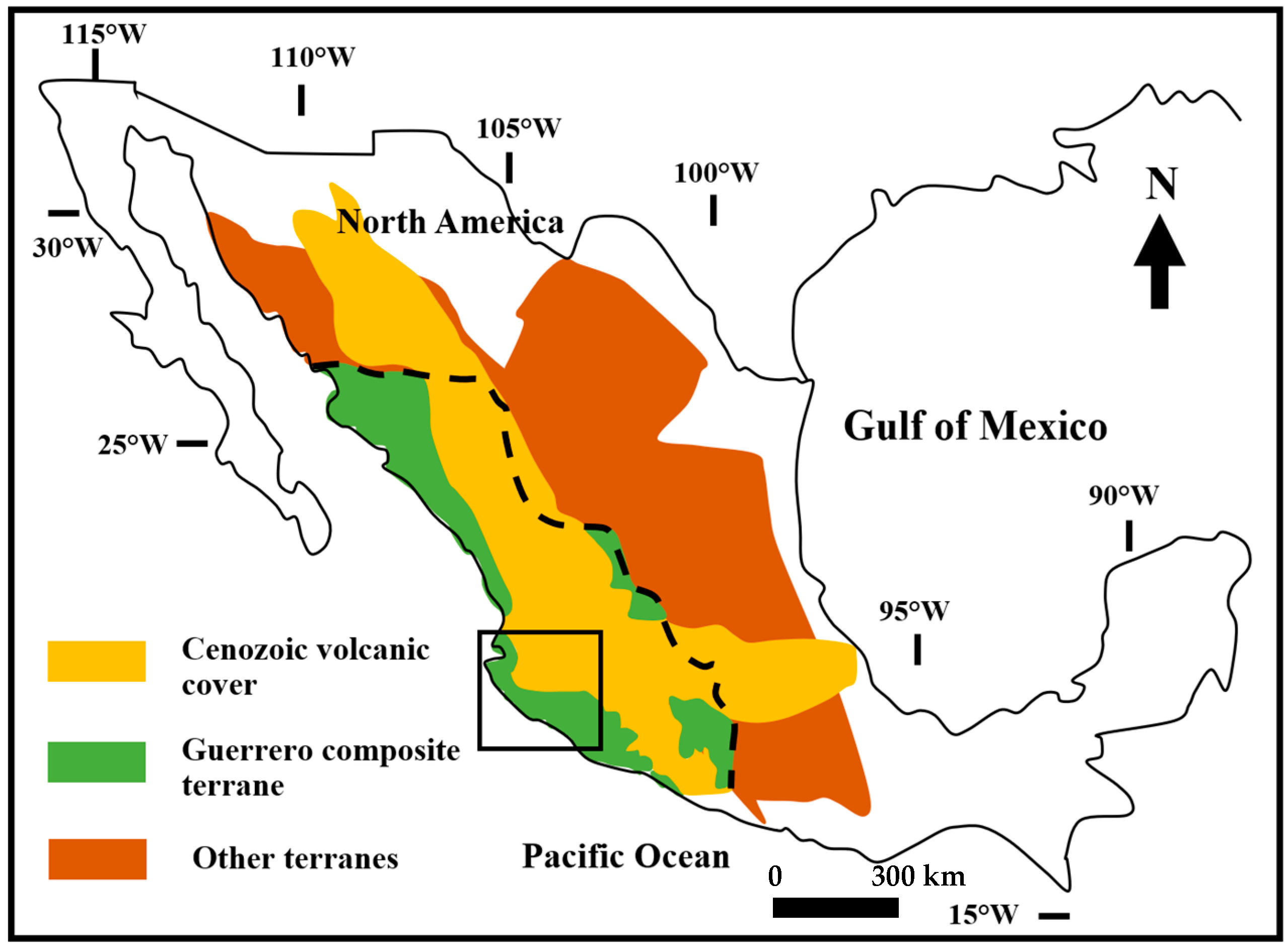
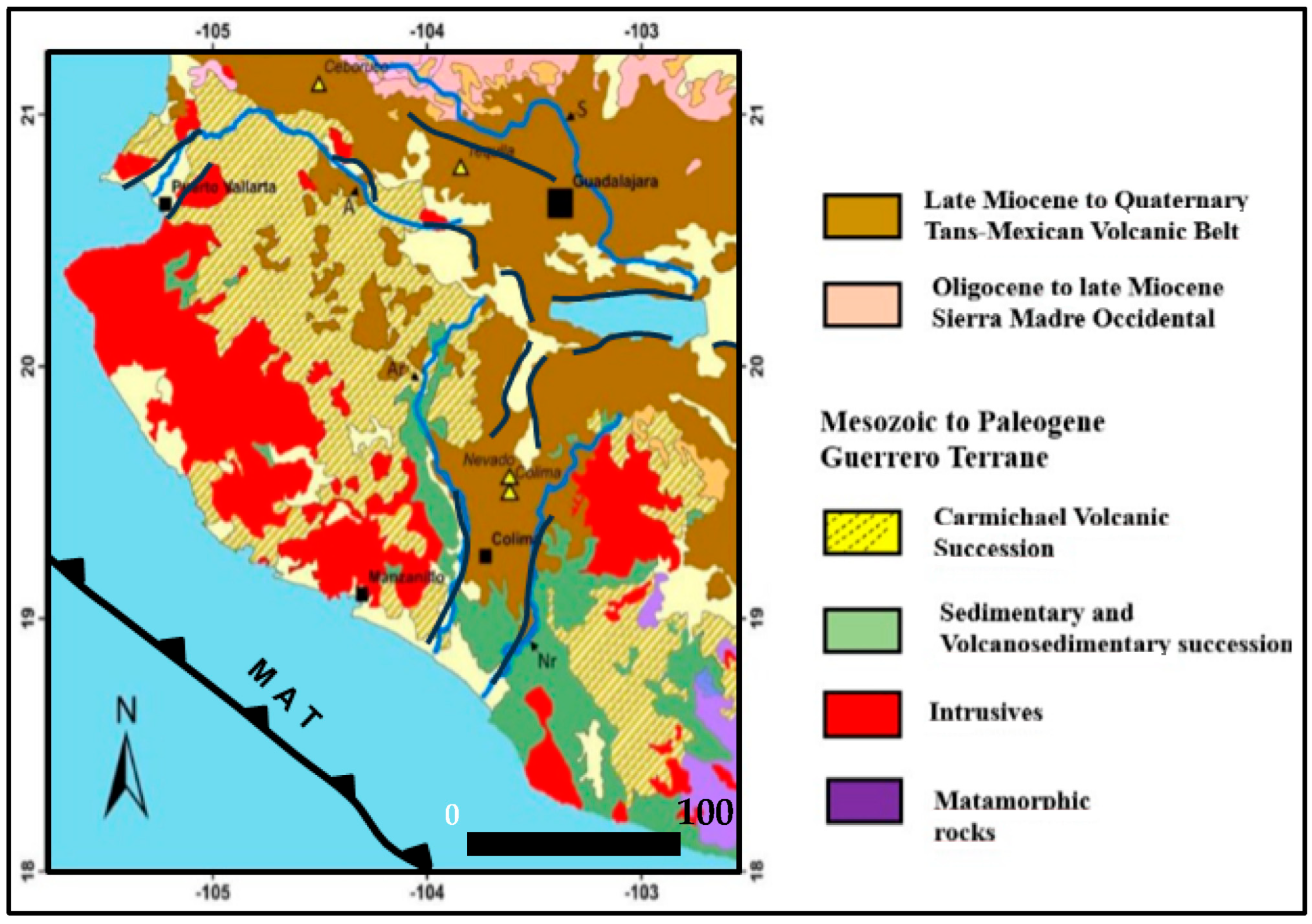
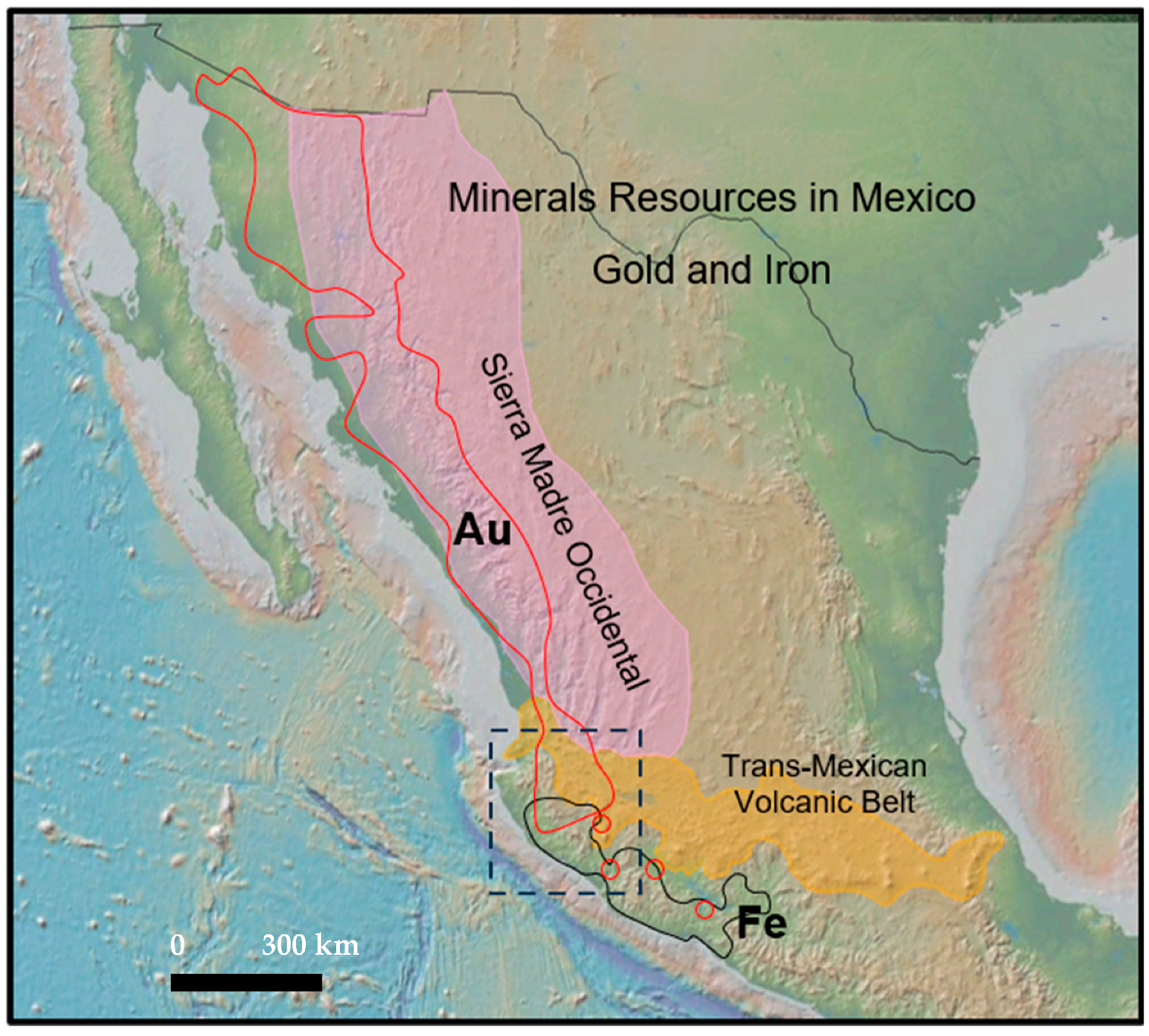
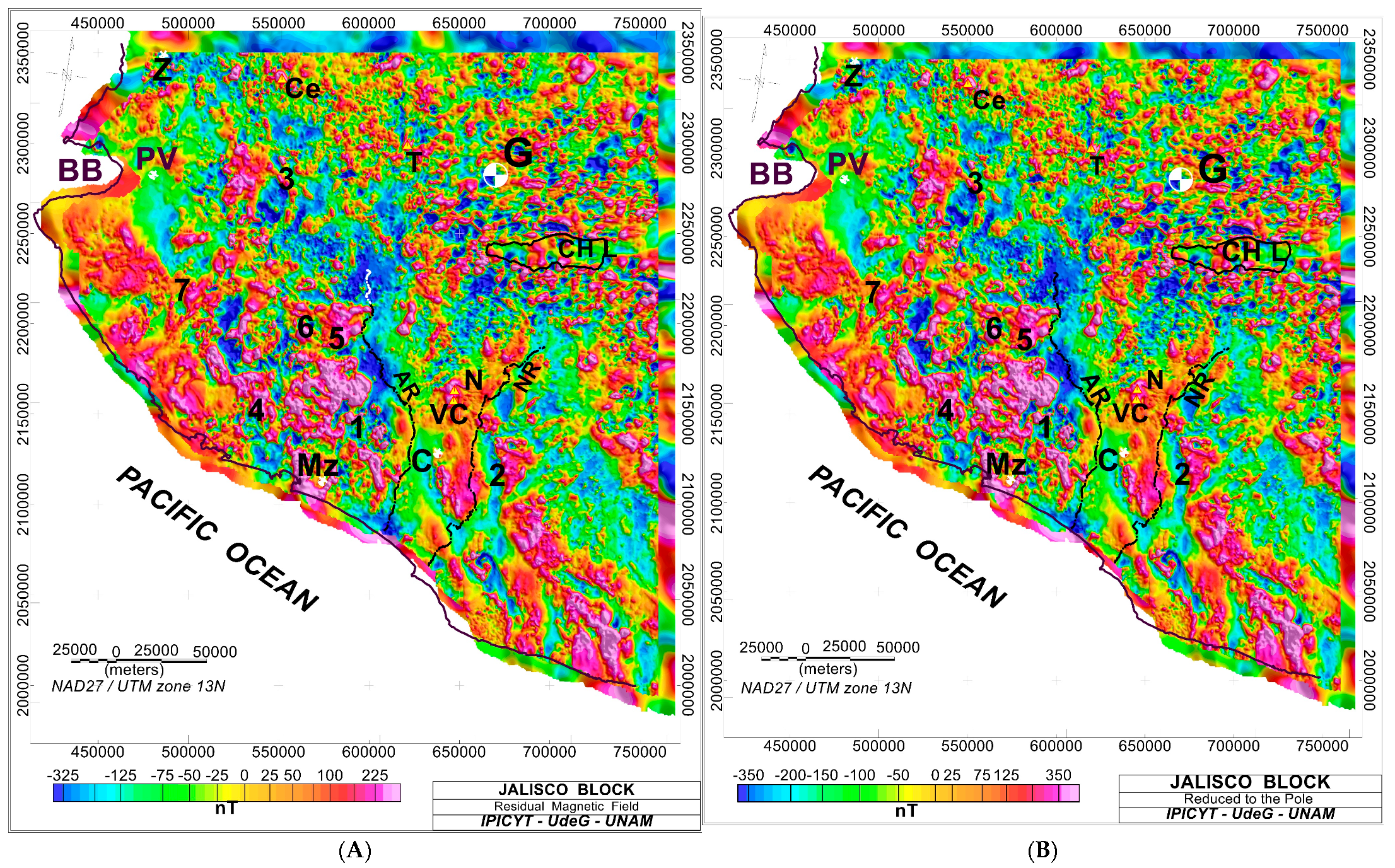
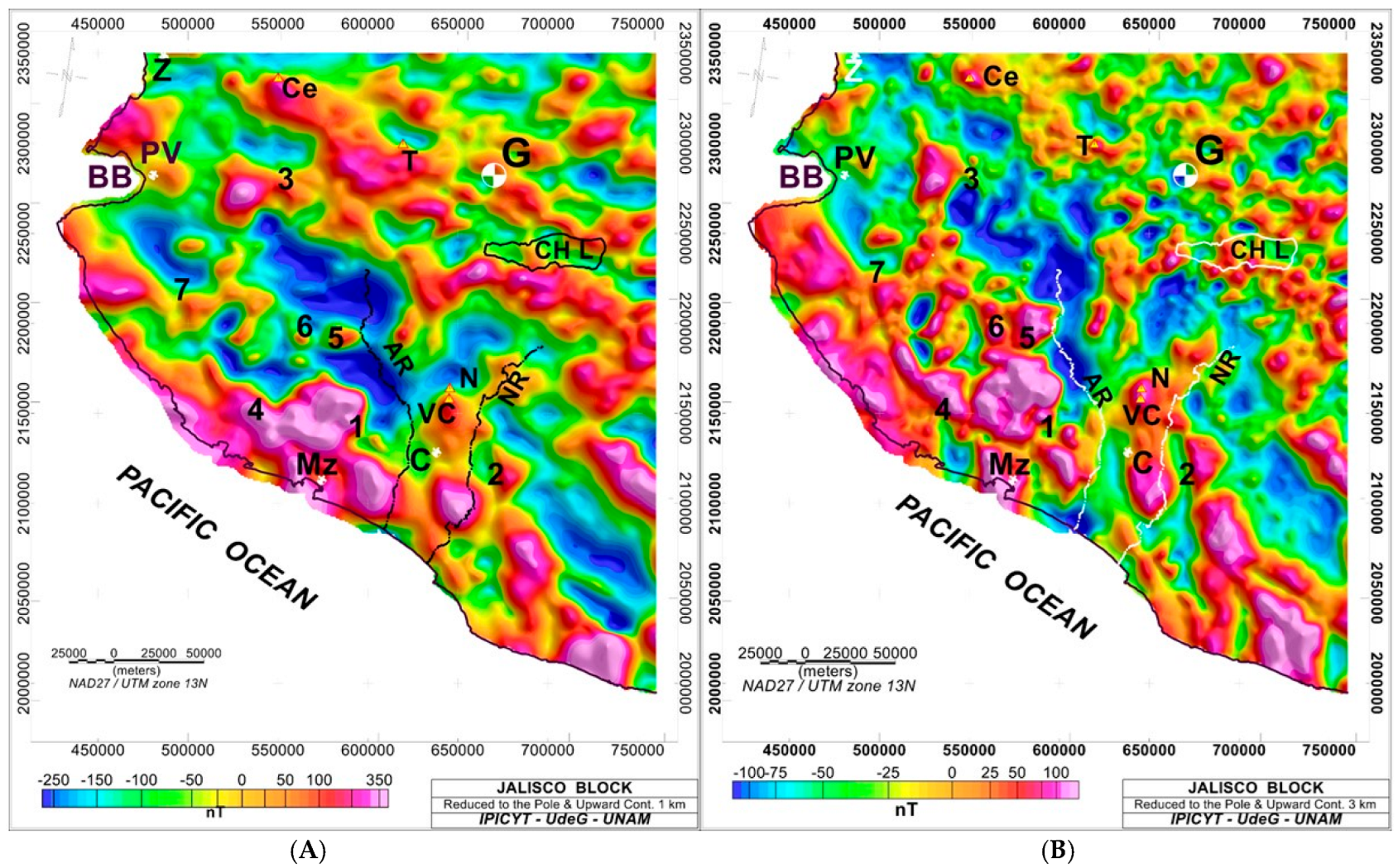
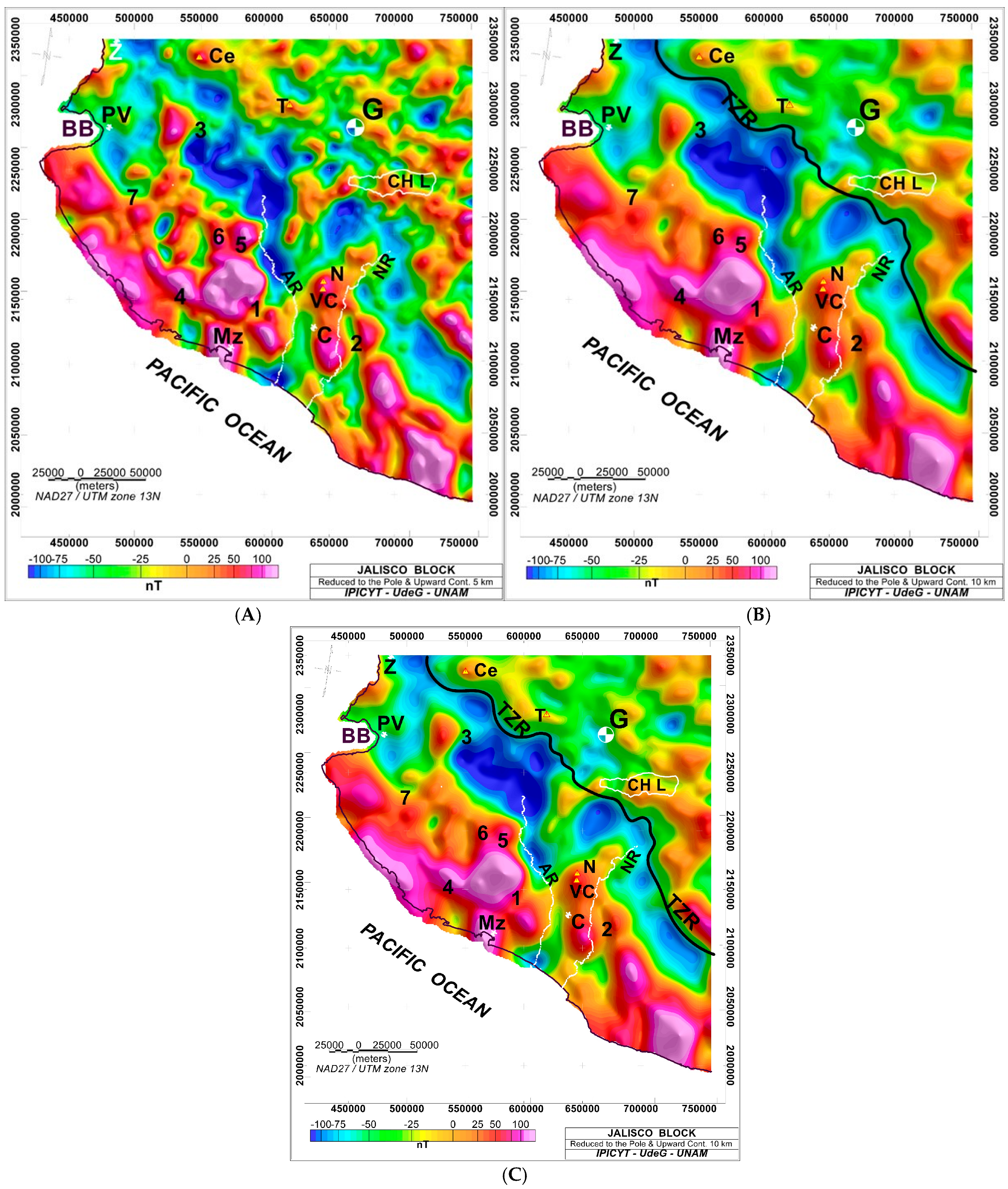
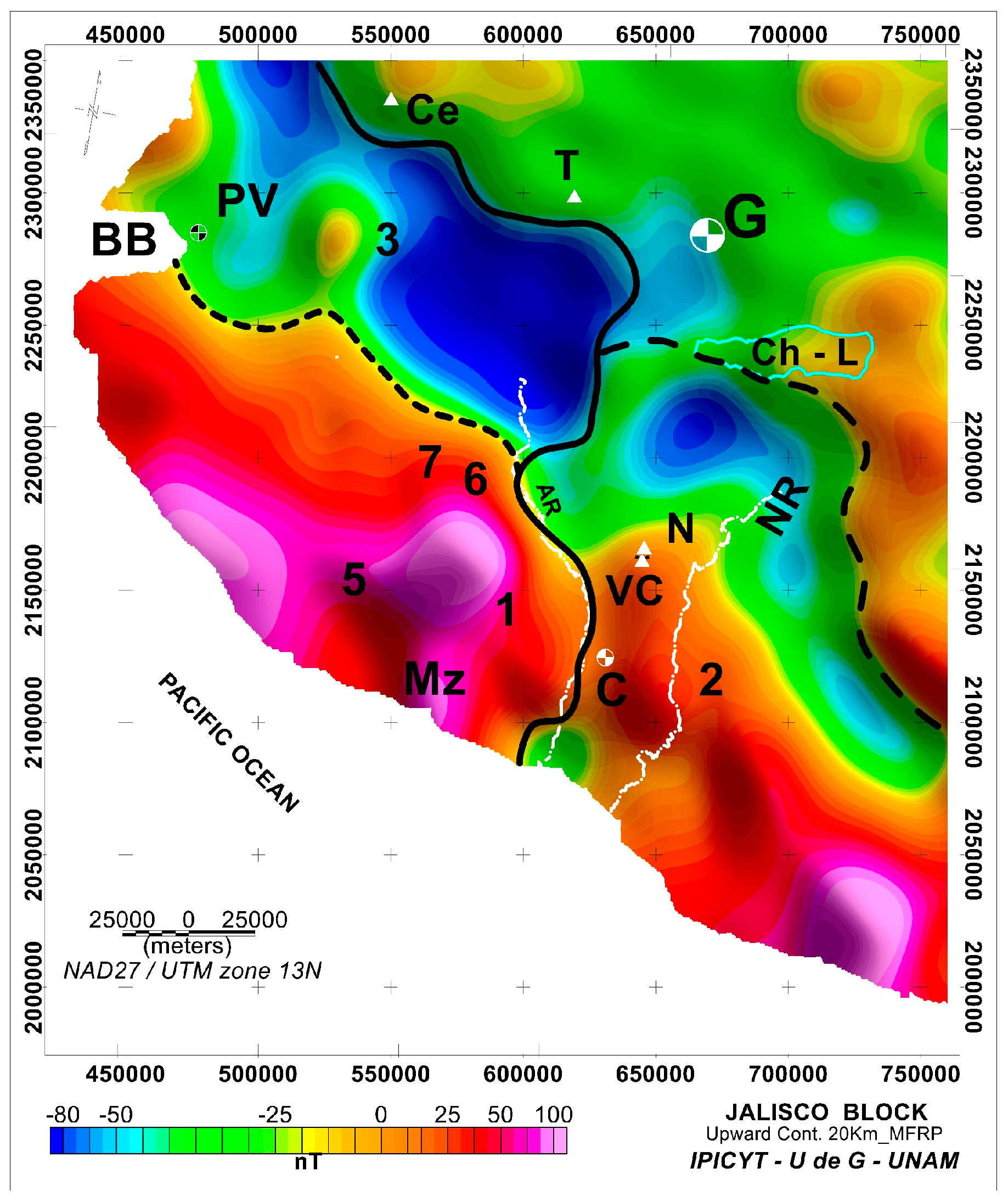
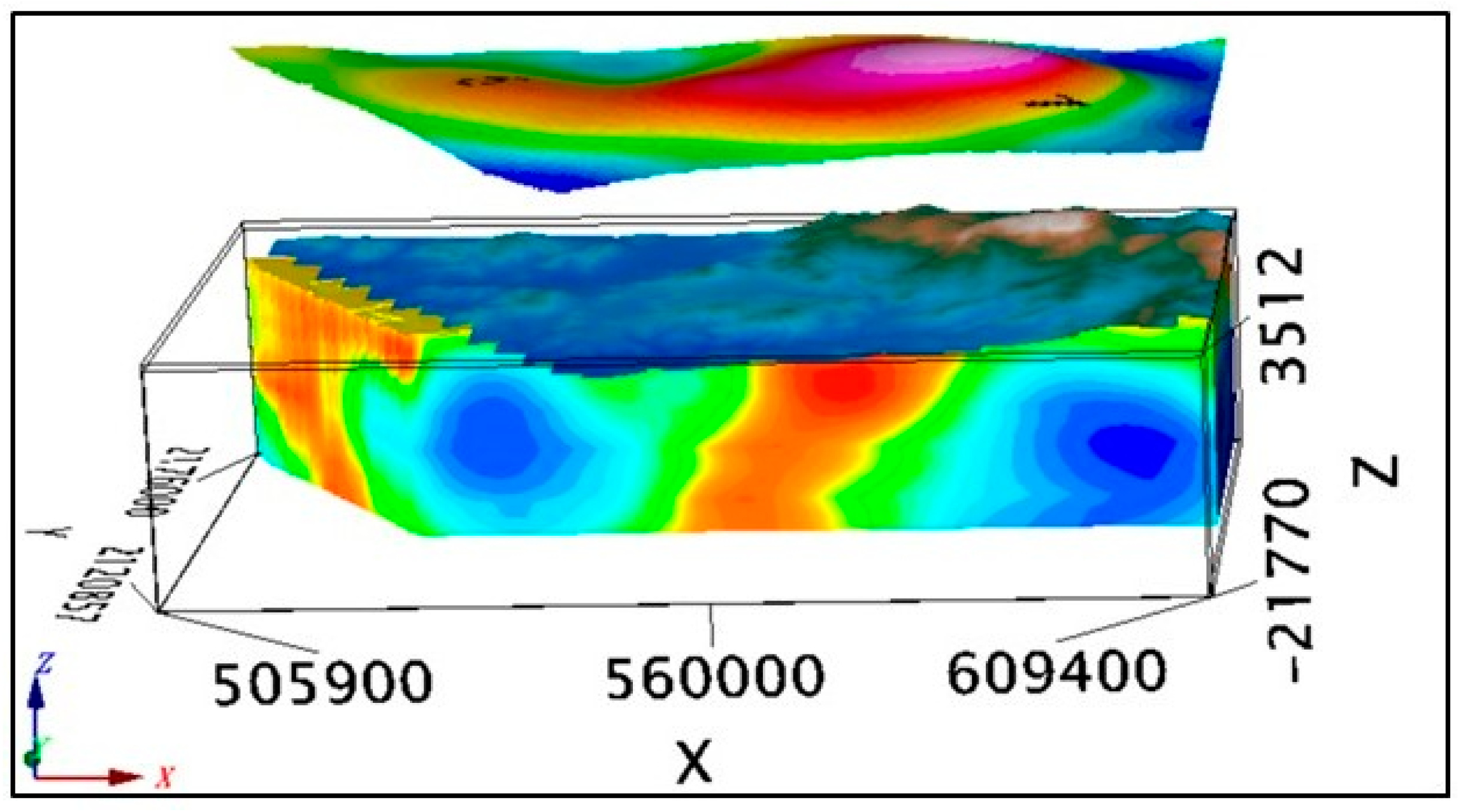



Disclaimer/Publisher’s Note: The statements, opinions and data contained in all publications are solely those of the individual author(s) and contributor(s) and not of MDPI and/or the editor(s). MDPI and/or the editor(s) disclaim responsibility for any injury to people or property resulting from any ideas, methods, instructions or products referred to in the content. |
© 2025 by the authors. Licensee MDPI, Basel, Switzerland. This article is an open access article distributed under the terms and conditions of the Creative Commons Attribution (CC BY) license (https://creativecommons.org/licenses/by/4.0/).
Share and Cite
Loera, H.L.; Rosas-Elguera, J.; Goguitchaichvili, A. The Shallow Structure of the Jalisco Block (Western Trans-Mexican Volcanic Belt) Inferred from Aeromagnetic Data—Implications for Mineral Deposits. Minerals 2025, 15, 858. https://doi.org/10.3390/min15080858
Loera HL, Rosas-Elguera J, Goguitchaichvili A. The Shallow Structure of the Jalisco Block (Western Trans-Mexican Volcanic Belt) Inferred from Aeromagnetic Data—Implications for Mineral Deposits. Minerals. 2025; 15(8):858. https://doi.org/10.3390/min15080858
Chicago/Turabian StyleLoera, Héctor López, José Rosas-Elguera, and Avto Goguitchaichvili. 2025. "The Shallow Structure of the Jalisco Block (Western Trans-Mexican Volcanic Belt) Inferred from Aeromagnetic Data—Implications for Mineral Deposits" Minerals 15, no. 8: 858. https://doi.org/10.3390/min15080858
APA StyleLoera, H. L., Rosas-Elguera, J., & Goguitchaichvili, A. (2025). The Shallow Structure of the Jalisco Block (Western Trans-Mexican Volcanic Belt) Inferred from Aeromagnetic Data—Implications for Mineral Deposits. Minerals, 15(8), 858. https://doi.org/10.3390/min15080858





